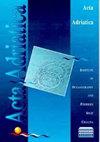hydromedusa Neotima lucullana(delle chiaje,1822)进入Neretva河口(克罗地亚亚得里亚海东南部)的生态系统
IF 0.6
4区 生物学
Q3 MARINE & FRESHWATER BIOLOGY
引用次数: 2
摘要
卢库拉水藻是地中海的特有物种。在这项研究中,我们记录了N.lucullana首次在Neretva河河口大量永久出现,这是这种典型海洋物种的一个不同寻常的栖息地。我们提供了该物种的COI条形码序列,这也是有史以来第一个发表的N.lucullana基因序列。2021年6月中旬至10月底,从奥普岑至梅特科维奇地区的自主潜水员和当地渔民的报告和记录中获得了关于N.lucullana的出现和丰度的每周数据。个体总是位于底部以上的层中,盐度在35.2和38.2之间。水母钟的直径从15毫米到72毫米不等,大多数在40毫米到58毫米之间。在所有大于25毫米的标本中都观察到性腺的不同发育。6月中旬,这些标本很常见,但很孤独。一周后,水母变得更加频繁,聚集得更小。从6月下旬到9月中旬,水母不断聚集在一起。到了秋天,个体数量逐渐减少,到10月的最后一周,只观察到单个个体。我们的研究结果表明,Neretva河口的生态系统发生了重大变化,并证实了在夏季和秋季观察到的以海洋物种为主的浮游动物群落的组成。本文章由计算机程序翻译,如有差异,请以英文原文为准。
Ingression of the hydromedusa Neotima lucullana
(delle chiaje, 1822) into the ecosystem of the Neretva river
estuary (south-eastern Adriatic, Croatia
Hydromedusa Neotima lucullana is an endemic species of the Mediterranean Sea. In this study we document the first numerous and permanent occurrence of N. lucullana in the estuary of the Neretva River, an unusual habitat for this typical marine species. We provide COI barcode sequence of this species, which is also first genetic sequence ever published of N. lucullana. Weekly data on the occurrence and abundance of N. lucullana were obtained from reports and records of autonomous divers and local fishermen in the area from Opuzen to Metković from mid-June to the end of October 2021. The individuals were always located in the layer above the bottom with salinity between 35.2 and 38.2. The diameters of the jellyfish bells ranged from 15 mm to 72 mm, most of them between 40 mm and 58 mm. Differential development of the gonads was observed in all specimens larger than 25 mm. In mid-June, the specimens were common but solitary. A week later, the jellyfish were more frequent and in smaller aggregations. From late June to mid-September, the jellyfish were constantly observed in larger aggregations. Toward the autumn, the number of individuals gradually decreased, and by the last week of October, only single individuals were observed. Our results indicate significant changes in the ecosystem of the Neretva estuary and confirm the observed composition of zooplankton communities dominated by marine species in summer and autumn.
求助全文
通过发布文献求助,成功后即可免费获取论文全文。
去求助
来源期刊

Acta Adriatica
生物-海洋与淡水生物学
CiteScore
1.60
自引率
11.10%
发文量
13
审稿时长
>12 weeks
期刊介绍:
Journal "Acta Adriatica" is an Open Access journal. Users are allowed to read, download, copy, redistribute, print, search and link to material, and alter, transform, or build upon the material, or use them for any other lawful purpose as long as they attribute the source in an appropriate manner according to the CC BY licence.
 求助内容:
求助内容: 应助结果提醒方式:
应助结果提醒方式:


